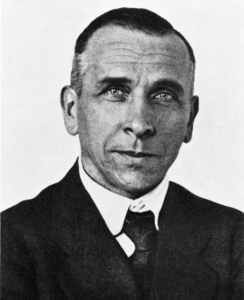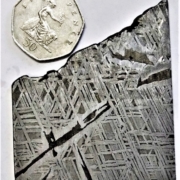Alfred Wegener: author of the theory of Continental Drift
Article by Dr Fred Starr PhD, FIMMM, FIE, MIMechE, CEng
It was just a mention from our Welsh Geography master, in one of the better schools of Stockton-on-Tees, where, back in the 1950s, I first heard of what is now loosely called Continental Drift. It was also from this teacher that I learnt that there was a paper called the “Manchester Guardian”. The only paper you can trust, he affirmed. Since 1961, under its new name, “The Guardian” I have been buying this left wing rag ever since. His purchasing of the Guardian and his espousal of what was then a somewhat weird account of Earth’s geological history, suggests that my Geography master was in a small but thinking minority. He was also against nuclear power, when the rest of Britain was all for it!
It was years afterwards, when I took up a casual interest in geology and fossil collecting that I learnt that it was the German, Alfred Wegener who was behind the idea of Continental Drift. But learning about the geology of Britain, I was struck by the fact that that hundreds of millions of years ago this country was covered by deserts. If it was that hot, at 55 degrees north, what was it like at the equator, I wondered? Literally boiling hot??? Continental drift would explain it all, but why didn’t died in the wool, professional geologists ask such an obvious question, instead of rejecting the theory.
Not really a gadfly
Alfred Wegener was also a man who was willing to go it alone, his life being spent in moving from one career track to another. Making a success of each, but gaining only partial recognition. Born in 1880, in Berlin, his PhD was in astronomical history, where he transcribed battered copies of the Alphonsine Planetary Tables, which dated from the 13th Century, into decimal notation. His supervisor must have been something of a sadist to suggest this.
From there Wegener joined the Aeronautische Observatorium (The Royal Prussian Aeronautical Observatory) at Lindenberg, near Berlin, which covered meteorology. Aeronautics as we know it, had still to find its place as an engineering science. Nevertheless, Wegener became an accomplished balloonist, this tying in with observations of the wind and weather. In 1906, along with his brother Kurt, he broke the world duration record, with a balloon flight of 52 hours. Going nowhere, but taking in vistas of Denmark, the Kattegat, and Sweden before, being blown back to Germany.
Later that year, he joined a Danish expedition to Greenland, making weather observations. These efforts got him a teaching position at the University of Marburg, where he became a gifted lecturer in meteorology and applied astronomy.
In 1914 along with most German men, he joined up, only to be wounded twice and declared unfit for combat. It was in hospital that he began to properly put down his thoughts on the drift of the Continents. Although still enlisted, and working, presumably as a weather forecaster, he heard about what came to be called the Treysa Meteorite. Based on what people had said, Wegener calculated the mean point of impact and posted a reward for its finding. It was quite a discovery. The meteor weighed over 60 kg and had an iron-nickel composition. The microstructure is, of course, of the barely explainable Widmanstatten type. A large piece of the meteor is on display at the Mineralogical Museum of Marburg, the town being only 30 km from the crash site

Alfred Wegener in or around 1924
After the war Wegener continued with his meteorological work, but was being passed over at Marburg, apparently because he was not pursuing the one track course expected of a professional academic. His ventures outside of weather forecasting must not have helped. Eventually, he got a good position at the University of Graz, but in 1930 he perished during another expedition to Greenland, attempting to rescue some of his associates.
The Continental Drift hypothesis
Almost every intelligent person has now heard of Continental Drift. I would not be surprised to hear that it is being taught in junior schools. The fact that the main Continental masses can be put together like pieces of a jigsaw puzzle would intrigue anyone. What may come as a surprise is that the battle for the idea was not won until the 1960s, when the evidence for it became incontrovertible.
The obvious ability to piece together of the opposing coastlines of Africa and South America had been noticed by others long before Wegener. But it was he who pointed out that when this was done there was a close correspondence between the geological formations and fossils in the two Continents. He then extended his ideas to argue that North America had split from Europe, and that Continental Drift could explain what we now term paleoclimates. A few papers were written which must have caused consternation in university colleagues. And it would also have provided an opportunity for a quiet bit of back stabbing, which I would add, is a full time occupation of many professional colleagues.

The Origin of Continents and Oceans, 1929
As a convalescing victim of the First World War, Wegener took the opportunity of his recuperation to cogitate upon and bring together his ideas. The result was a book, entitled “Die Entstehung der Kontinente und Ozeane”, slightly inaccurately translated as “The Origin of Continents and Oceans”. It went through four editions, the third, 1925 edition being translated, it having a fairly good review in “Nature”. But I wonder how widespread were the sales, the translation being priced at 10s 6d (£0.525) almost a day’s pay in England at the time. I suspect most geologists and anyone interested in the geological origin of the Earth would have heard about the theory at third or fourth hand. Generally, the concept was dismissed in Britain and, especially, America as an interesting delusion from someone who was not a professional geologist. The antipathy towards Germany and German Scientists, at the time, was very strong, and cannot have helped.
A Britisher to the rescue
The most valid criticism was that Wegener could not offer a mechanism for why, at times, the Continents could drift apart, and at other times collide, the result being massive mountain building as with the Alps and Himalayas. Here in Britain, Arthur Holmes, ten years younger than Wegener had provided the basis of an answer. Radioactivity, then a newly discovered phenomenon, was the reason why the rocks, below the crustal layers are red hot. We see the effects in outpouring of lava from volcanoes. Holmes realised that there must be a continuous circulation of red hot semi molten magma, underlying the crust of the earth, and that could cause the continents to move like collections of soap bubbles in a kitchen sink.
Holmes’ exposition of what one might term the convection theory was the first step to show how the movement of the semi molten magma could split a Continent. His ideas were outlined in 1944 in the final chapter his “Principles of Physical Geology! It is a book which is considered, from the clarity of expression, to be one of the best efforts on the subject. The ability to get ideas over was something Holmes shared with Wegener, and it undoubtedly gave the Continental Drift credibility in Britain. It seems likely that my Geography master would have read this book. What a pity Wegener and Holmes never met!
Looking to the future
Nevertheless, Holmes, apparently, didn’t quite support Continental Drift, even towards the end of his life. Both his ideas and those of Wegener have been greatly modified in the light of the discovery of the magnetic stripes on the Atlantic seafloor and the actual measurement of the rate and direction of the movement of the Continents.
It is now agreed that the Continents sit on “tectonic” plates that move around the Earth, under the influence of convection current in the magma. As such, Southern Europeans, a few million years hence, can look to a closing of the Straits of Gibraltar, with the drying up of the Mediterranean, leaving a vast salt desert behind. Wind blown salt poisoning the olive and wine groves of Spain, Italy and Greece. Eventually, as Africa piles northwards into Europe, the Med disappears altogether along with the Red Sea. On the other side of the World, Australia makes rapid progress, in geological terms, northwards, eventually colliding with the archipelagos and islands of South East Asia. The internet has quite a few simulations of Future Earth, which are fun to look at. They show that 250 million years into the future, about as far distant as we are from the early dinosaurs, all the Continents come together, so that we are “One World” at last. Something the EU Commission looks forward to, with anticipation. Or is it the Chinese?
What would Alfred Wegener have made of these predictions? From what one understands of him, the triumph of his ideas would not have gone to his head. But in a way, and just as important, Continental Drift and Tectonic Plates have allowed the English speaking world to know of one great German, who has changed our vision of our place in time and space.





